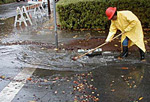The State of World Population 2009 argues that the fight against climate change is more likely to be successful if policies, programs and treaties take into account the needs, rights and potential of women.
Officials from the Weed Science Society of America reported to EPA that nine weed species are now resistant to glyphosate, the nation's most widely used herbicide, but also offered some best management practices to deal with the problem.
Ryerson, Master and Associates developed a comprehensive carbon footprint for the agency, following extensive analysis to determine the best methodologies for the job.
A Dec. 1 public meeting will be held in Moulton, Ala., to share information with residents on the status of the investigation.

Two case studies illustrate how companies found in violation of environmental law can offset some of the costs associated with financial penalties.

Energy-saving fluorescent lamps pose mercury vapor risks when broken and require special packaging for their transport to recycling facilities.
- By Brad Buscher, chair and CEO of VaporLok Products LLC
Effective immediately, all boat sewage will have to be discharged at equipped pump-out facilities, not into the South Shore Estuary.
Schuiteman Feedlots will no longer hold its cattle in open feedlots, which should prevent the discharge of manure or wastewater into the West Branch of the Floyd River in Sioux City, Iowa.
Researchers also found that rice fields irrigated with water containing arsenic filtered out much of the poison from the water system.
According to a new report from McGraw-Hill Construction, customer demands and regulatory pressures are driving green building construction.
Jane Caffrey of the University of West Florida says the $25,000 grant will fund a graduate student project to help analyze nutrient and continuous dissolve oxygen data from research reserves.
Former Atomics International, Rocketdyne, and Rockwell employees are encouraged to contact EPA about its Santa Susana Field Lab radiological study.
EPA will award grants between $200,000 and $600,000 for direct, local action to benefit the Puget Sound ecosystem.